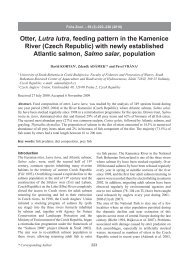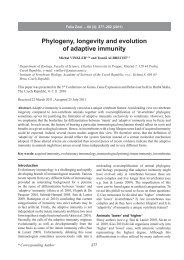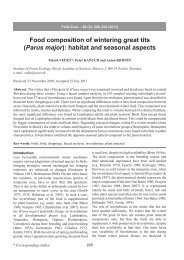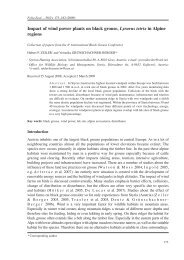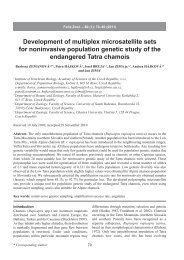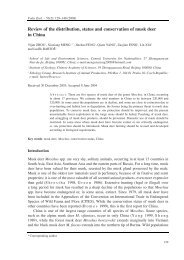alterations in ichthyofauna of the largest rivers
alterations in ichthyofauna of the largest rivers
alterations in ichthyofauna of the largest rivers
Create successful ePaper yourself
Turn your PDF publications into a flip-book with our unique Google optimized e-Paper software.
Some <strong>of</strong> <strong>the</strong>m (A. brama, A. bjoerkna, A. alburnus, R. rutilus) occur <strong>in</strong> all <strong>rivers</strong>, channels,<br />
lakes, and reservoirs, and also <strong>in</strong> <strong>the</strong> delta and brackish waters; whereas L. del<strong>in</strong>eatus, T. t<strong>in</strong>ca<br />
and S. erythrophthalmus ma<strong>in</strong>ly occur <strong>in</strong> lakes, tributaries and reservoirs; and L. idus is most<br />
abundant <strong>in</strong> flow<strong>in</strong>g waters. Some less distributed species are Abramis ballerus, A. sapa, Aspius<br />
aspius, Carassius auratus, C. carassius, Sander lucioperca, and Neogobius fluviatilis. The first<br />
three species and S. lucioperca occur more <strong>of</strong>ten <strong>in</strong> <strong>rivers</strong>, large lakes and reservoirs, whereas<br />
C. auratus and C. carassius are more common <strong>in</strong> <strong>the</strong> Lower Don, <strong>in</strong> its lakes and reservoirs<br />
(Fedorov 1960, 1970, P oznyak 1987, T roitskii & Tsunikova 1988,<br />
Babushk<strong>in</strong> 1990, Klyav<strong>in</strong> 1992, Davydenko 1995).<br />
The distribution <strong>of</strong> some o<strong>the</strong>r native species is ma<strong>in</strong>ly limited to certa<strong>in</strong> parts <strong>of</strong> <strong>the</strong><br />
bas<strong>in</strong>. Thus, Cypr<strong>in</strong>us carpio is common and abundant <strong>in</strong> <strong>the</strong> Lower Don bas<strong>in</strong> and rare <strong>in</strong><br />
<strong>the</strong> Upper Don, whereas Phox<strong>in</strong>us phox<strong>in</strong>us is distributed <strong>in</strong> <strong>the</strong> Upper Don bas<strong>in</strong> only<br />
(Davydenko 1995). Recent data <strong>in</strong>dicated that Cobitis taenia occurs <strong>in</strong> <strong>the</strong> Upper Don<br />
bas<strong>in</strong>: several specimens <strong>of</strong> this species were collected by B. Lev<strong>in</strong> <strong>in</strong> <strong>the</strong> Khoper River<br />
(Penza District) toge<strong>the</strong>r with Cobitis rossomeridionalis, <strong>the</strong> most numerous and common<br />
loach <strong>in</strong> <strong>the</strong> Don River bas<strong>in</strong> (V asiºeva & Vasiºev 1998).<br />
Thirteen mar<strong>in</strong>e or euryhal<strong>in</strong>e species occur <strong>in</strong> <strong>the</strong> Lower Don. Neogobius<br />
gymnotrachelus and N. melanostomus are very rare <strong>the</strong>re and are recorded for Tsimlyanskoye<br />
Reservoir, whereas Benthophilus magistri is quite common. A<strong>the</strong>r<strong>in</strong>a boyeri is distributed up<br />
to city <strong>of</strong> Rostov, and Gasterosteus aculeatus is recorded for <strong>the</strong> Lower Don and <strong>the</strong> Sal<br />
River. Percar<strong>in</strong>a demid<strong>of</strong>fi, Caspiosoma caspium, and Mesogobius batrachocephalus occur<br />
rarely <strong>in</strong> <strong>the</strong> Don mouth only. Benthophilus stellatus occurs up to <strong>the</strong> city <strong>of</strong> Voronezh, and<br />
Neogobius syrman is rare up to Aksai. Knipowitschia longecaudata occurs <strong>in</strong> <strong>the</strong> delta, <strong>in</strong> <strong>the</strong><br />
ma<strong>in</strong> river channel up to Kokchetavskaya and <strong>in</strong> Tsimlyanskoye Reservoir and reservoirs <strong>of</strong><br />
<strong>the</strong> Manych River dra<strong>in</strong>age. Clupeonella cultriventris <strong>in</strong>habits <strong>the</strong> delta, Tsimlyanskoye<br />
Reservoir, some reservoirs <strong>of</strong> <strong>the</strong> Manych River dra<strong>in</strong>age, and is randomly distributed <strong>in</strong> <strong>the</strong><br />
Upper Don. Syngnathus abaster is found <strong>in</strong> reservoirs <strong>of</strong> <strong>the</strong> Manych River dra<strong>in</strong>age and <strong>in</strong><br />
<strong>the</strong> Donets River bas<strong>in</strong> (F edorov 1970, T roitskii & Tsunikova 1988,<br />
Poznyak 1987, Dentshik 1997, V asiºeva 1998).<br />
There are 10 protected species <strong>of</strong> <strong>the</strong> Red books <strong>of</strong> <strong>the</strong> Ukra<strong>in</strong>e and Russia that occur <strong>in</strong><br />
<strong>the</strong> Don River bas<strong>in</strong>: 1) Metamorphosed specimens <strong>of</strong> Eudontomyzon mariae are very rare,<br />
and <strong>in</strong> <strong>the</strong> breed<strong>in</strong>g season <strong>the</strong>y occur <strong>in</strong> some small streams <strong>of</strong> <strong>the</strong> Upper Don<br />
(Babushk<strong>in</strong> 1990). Ammocoetes more or less <strong>of</strong>ten occur <strong>in</strong> some parts <strong>of</strong> <strong>the</strong> bas<strong>in</strong>: <strong>in</strong><br />
<strong>the</strong> Donets, Voronezh and Khoper <strong>rivers</strong> and some lakes and small streams <strong>of</strong> <strong>the</strong>ir bas<strong>in</strong>s<br />
(Fedorov 1960, Red book <strong>of</strong> Ukra<strong>in</strong>e 1994, D avydenko 1995, L ev<strong>in</strong> 2001);<br />
2) Anadromous Acipenser nudiventris is becom<strong>in</strong>g endangered and is protected <strong>in</strong> <strong>the</strong><br />
Ukra<strong>in</strong>e and Russia; 3) Acipenser ru<strong>the</strong>nus is becom<strong>in</strong>g very rare <strong>in</strong> <strong>the</strong> Don River bas<strong>in</strong><br />
(Khoper) and has completely disappeared from some its tributaries (Donets) (Red book <strong>of</strong><br />
Ukra<strong>in</strong>e 1994, Davydenko 1995); 4) Anadromous Huso huso lost all breed<strong>in</strong>g sites <strong>in</strong><br />
<strong>the</strong> Upper Don after construction <strong>of</strong> <strong>the</strong> Tsimlyanskoye Reservoir, its numbers have<br />
decreased sharply, and <strong>the</strong> population is ma<strong>in</strong>ta<strong>in</strong>ed by artificial reproduction only.<br />
Excessive fish<strong>in</strong>g has caused fur<strong>the</strong>r decl<strong>in</strong>e <strong>in</strong> its numbers. Now, this species is very rare<br />
and practically ext<strong>in</strong>ct <strong>in</strong> most <strong>of</strong> <strong>the</strong> bas<strong>in</strong>; 5) Alburnoides bipunctatus is rare <strong>in</strong> <strong>the</strong> Upper<br />
Don despite previous records <strong>in</strong> <strong>the</strong> Khoper and Donets Rivers (B e r g 1949a, Fedorov<br />
1960) where it has become very rare (Khoper, Davydenko 1995) and possibly ext<strong>in</strong>ct<br />
(Donets, Movchan & Smirnov 1983); 6) Chalcalburnus chalcoides was previously<br />
abundant <strong>in</strong> gulfs and estuaries <strong>of</strong> <strong>the</strong> Sea <strong>of</strong> Azov (sal<strong>in</strong>ity 10–12 % ° ), but had restricted<br />
343



